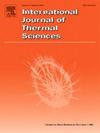Microscopic analysis of the influence of nanoparticle shape and solid-liquid interfacial layer density on the thermal conductivity of nanofluids: A molecular dynamics study on Cu-H2O nanofluids
IF 4.9
2区 工程技术
Q1 ENGINEERING, MECHANICAL
International Journal of Thermal Sciences
Pub Date : 2025-03-07
DOI:10.1016/j.ijthermalsci.2025.109838
引用次数: 0
Abstract
Nanofluids are known for their excellent heat transfer properties, making the investigation of mechanisms to enhance thermal conductivity highly significant. Although previous studies have examined how thermal conductivity varies with temperature, nanoparticle shape, and volume fraction, detailed microscopic analyses of how nanoparticle shape and the interfacial layer between nanoparticles and the base fluid influence thermal conductivity remain limited. In this study, we focus on Cu-H2O nanofluids, employing molecular dynamics combined with the non-equilibrium molecular dynamics (NEMD) method to simulate the thermal conductivity under various conditions, including temperature, nanoparticle shape (with different surface area-to-volume ratios, S/V), and volume fraction. We observed that nanoparticles with higher surface area-to-volume (S/V) ratios significantly enhanced the thermal conductivity of nanofluids. For instance, as the S/V ratio increased from 0.31746 to 0.805, the thermal conductivity enhancement rate rose from 11 % to 30 %. Visualization and number density analyses revealed that the aggregation of water molecules around nanoparticles decreased with lower S/V ratios, as indicated by the reduction in peak number density from 0.0749333 to 0.0745075. This indicates that nanoparticle shape influences nanofluid thermal conductivity by altering the density of the solid-liquid interfacial layer. RDF analysis showed that in water-based nanofluids, the Cu-O peak position shifted closer to the nanoparticle surface as the volume fraction increased (e.g., for spherical nanoparticles, the peak shifted from 3.125 Å at 0.5 % to 2.925 Å at 2.5 %), revealing the microscopic mechanism by which increased volume fractions enhance thermal conductivity. Further analysis demonstrated that the S/V ratio of nanoparticles significantly affects the interfacial layer density, as reflected in the Cu-O g(r) peak height, which followed the order: sheet-like (1.21293) > cubic (0.8675) > spherical (0.83449) > cylindrical (0.67553). This sequence corresponds to the S/V ratio and aligns with the observed trend in thermal conductivity. Finally, MSD analysis of dispersion performance indicated that the diffusion coefficients of nanoparticles were ordered as cylindrical (3.833), spherical (4.000), cubic (4.167), and sheet-like (4.525), consistent with their respective S/V ratios. These findings confirm that nanoparticle motion intensity, reflected by diffusion coefficients, is closely related to S/V ratios, further supporting the microscopic mechanism by which S/V ratios influence nanofluid thermal conductivity.This study provides a deeper understanding of the relationship between nanoparticle shape, interfacial density, and thermal conductivity, offering insights into the microscopic mechanisms and guiding future molecular dynamics studies of nanofluids.
求助全文
约1分钟内获得全文
求助全文
来源期刊

International Journal of Thermal Sciences
工程技术-工程:机械
CiteScore
8.10
自引率
11.10%
发文量
531
审稿时长
55 days
期刊介绍:
The International Journal of Thermal Sciences is a journal devoted to the publication of fundamental studies on the physics of transfer processes in general, with an emphasis on thermal aspects and also applied research on various processes, energy systems and the environment. Articles are published in English and French, and are subject to peer review.
The fundamental subjects considered within the scope of the journal are:
* Heat and relevant mass transfer at all scales (nano, micro and macro) and in all types of material (heterogeneous, composites, biological,...) and fluid flow
* Forced, natural or mixed convection in reactive or non-reactive media
* Single or multi–phase fluid flow with or without phase change
* Near–and far–field radiative heat transfer
* Combined modes of heat transfer in complex systems (for example, plasmas, biological, geological,...)
* Multiscale modelling
The applied research topics include:
* Heat exchangers, heat pipes, cooling processes
* Transport phenomena taking place in industrial processes (chemical, food and agricultural, metallurgical, space and aeronautical, automobile industries)
* Nano–and micro–technology for energy, space, biosystems and devices
* Heat transport analysis in advanced systems
* Impact of energy–related processes on environment, and emerging energy systems
The study of thermophysical properties of materials and fluids, thermal measurement techniques, inverse methods, and the developments of experimental methods are within the scope of the International Journal of Thermal Sciences which also covers the modelling, and numerical methods applied to thermal transfer.
 求助内容:
求助内容: 应助结果提醒方式:
应助结果提醒方式:


